South Wales and South England boundaries
The region includes the high demand area of London, generation around the Thames estuary and the long set of circuits that run around the South Coast and South Wales.
Interconnection to Central Europe is connected along the Southeast Coast, and this interconnection has significant influence on power flows in the region by being able to both import and export power with Europe.
The South of England transmission region includes boundaries B13, B14, LE1, SC1, SC1.5, SC2, SC3 and SW1.
The map below shows the general pattern of power flow directions expected to occur at winter peak in the years to come up to 2036, i.e. power will generally flow from north to south. The arrows in the diagram illustrate power flow directions and are approximately scaled relative to the winter peak flows.

Regional drivers
Network management will be critical in this region due to European interconnection developments and contrasting network topology, causing potential high circuit flows leading to overloading, voltage management and stability issues.
The transmission network in the south is densely meshed in and around the London boundary B14 and the Thames estuary, but moving South and towards the West, the network is much more radial with longer distances between each substation. Most interconnectors will be connected south of boundary SC1, the impact of these will be discussed later in the chapter in the SC1, SC1.5 and SC2 requirements sections.
All pathways suggests that a total of around 9GW of interconnectors and energy storage capacity will be connected by 2030, up from about 6.5GW to date. Interconnectors and storage are bidirectional, meaning that the south could see their capacity provide almost 9GW power injection or 9GW increased demand, placing a heavy burden on the transmission network.
With new interconnector and generation connections, boundaries SC1, SC1.5, SC2, SC3, LE1 and B13 will need to be able to support large power flows in both directions. The South will be expected to fulfil a lower portion of its demand from local embedded generation than other regions are. With future additional interconnector connections, in the south region it will be challenging to support all interconnectors importing or exporting simultaneously without network reinforcement.
Generation Capacity
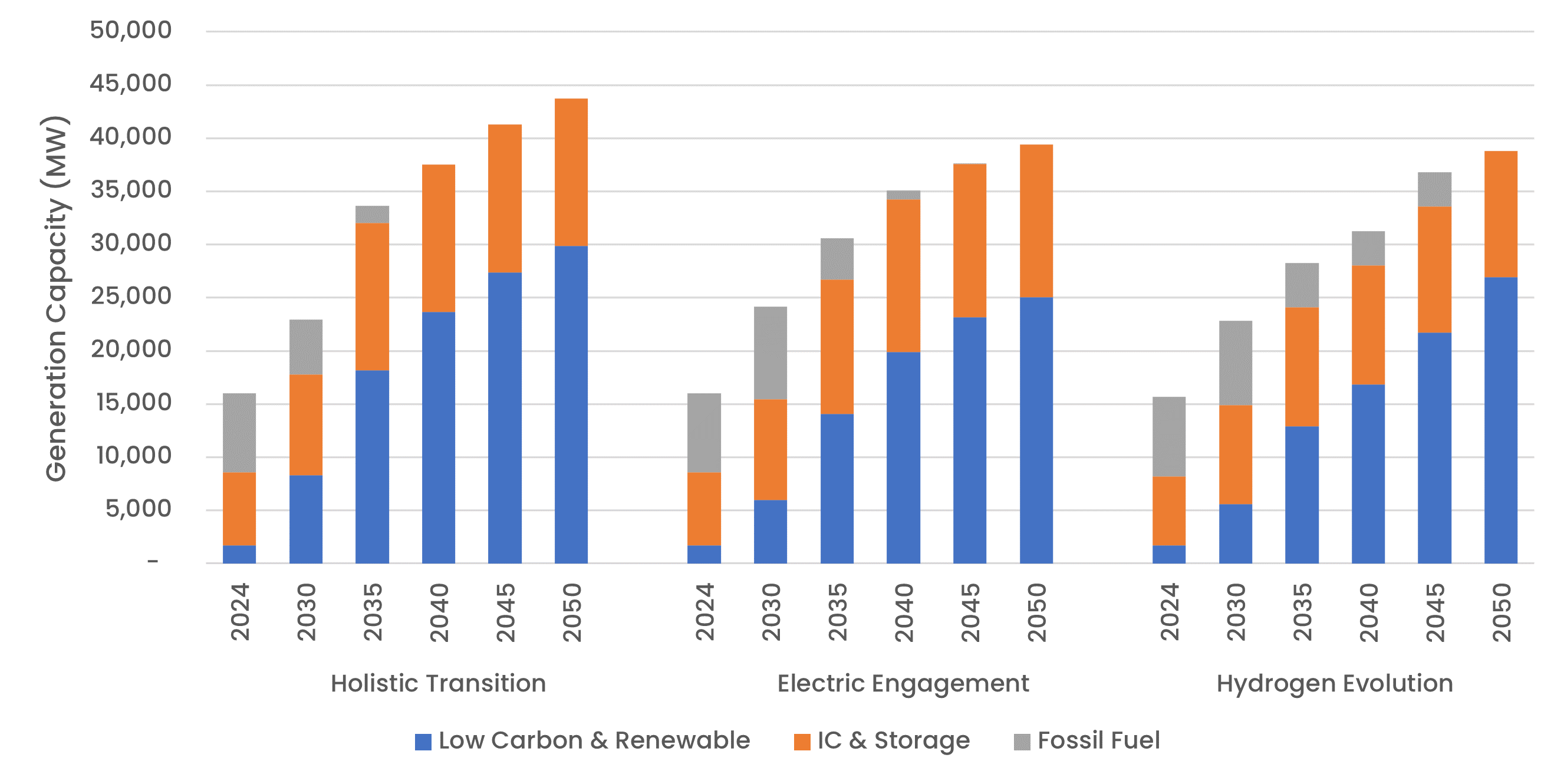
Gross Demand

High voltages in London arise from the high gain of numerous cable circuits, particularly overnight when demand is low. The Voltage 2026 tender has also procured capability in this region to manage these high-voltage issues in future. In future years, low-voltage issues are expected to become more prevalent around London during high-flow periods, particularly when the south-coast interconnectors are exporting power.
Boundary regions
Click on the regions below to expand the boundary and understand its capability and challenges.
The graphs show a distribution of power flows for each of our Future Energy Scenarios, in addition to the boundary power transfer capability and NETS SQSS requirements for the next 20 years.
Each scenario has different generation and demand so produces different boundary power flow expectations. From applying the methodology in the NETS SQSS for wider boundary planning requirements (as discussed in the previous chapter), we determine for each scenario:
- The economy criteria - solid coloured line
- Security criteria - dashed coloured line
- Current and future NOA capability (where available) - solid red line
The capability line (red line) is based on the recommendations from the Beyond 2030 report. More information about the NOA methodology can be found here. The 50%, 90%, economy required transfer (RT) and Security RT are calculated from the 2023 FES and ETYS processes. Where the NOA transfer capability is not available, there is a red line that provides the transfer capability from ETYS 2022.
Note: Boundary capability line is affected by the generation and demand profiles within each FES background. Therefore, the graphs are provided for indicative purposes only and cannot be directly compared.
The calculations of the annual boundary flow are based on unconstrained market operation, meaning network restrictions are not applied. This way, the minimum cost generation output profile can be found. We can see where the expected future growing needs could be by looking at the power flows in comparison with boundary capability.
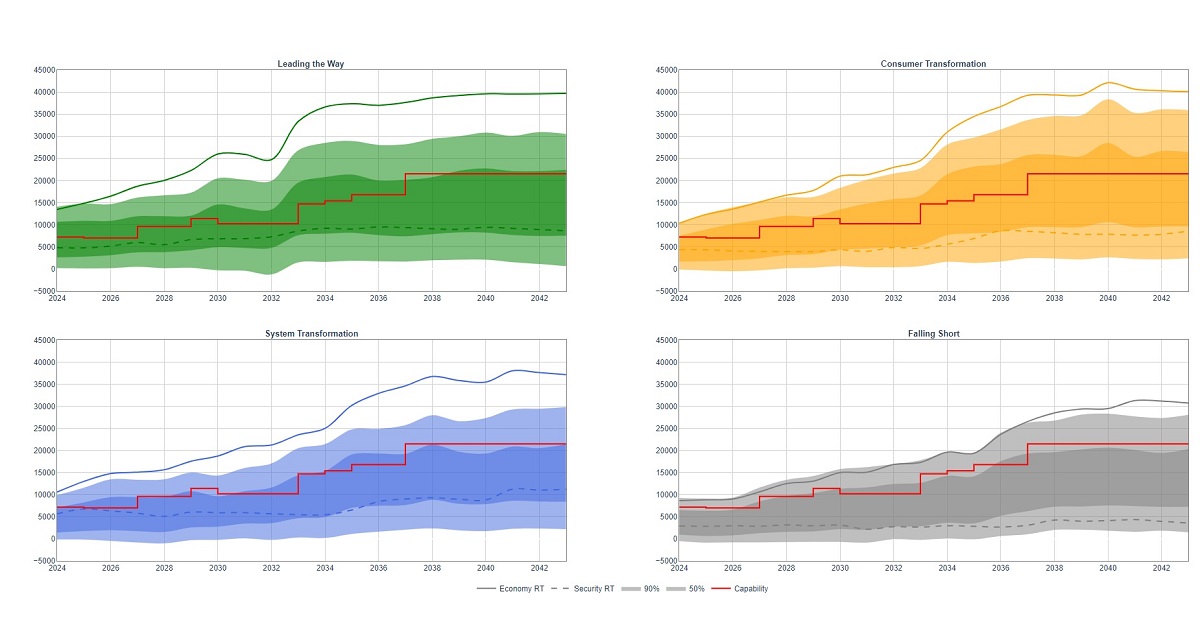
View an interactive version of the graph
On each graph, the two shaded areas provide confidence as to what the power flows would be across each boundary:
- The darker region shows 50% of the annual power flows
- The lighter region shows 90% of the annual power flows
From the regions, we can show how often the power flows expected in the region split by the boundary are within its capability (red line). If the capability of the boundary is lower than the two regions over the next 20 years, there might be a need for reinforcements to increase the capability. However, if the line is above the shaded regions, it shows that there should be sufficient capability here and that potentially no reinforcements are needed from a free market power flow perspective until the shaded regions exceed the capability (red line).

The southwest peninsula is a region with a high level of localised generation and demand. Until new generation or interconnectors connect there is very little variation in boundary requirements for B13, and that the current importing boundary capability is sufficient to meet the short-term needs.
The large size of the potential new generators wishing to connect close to boundary B13 is likely to push it to large exports but the current network plan in raises boundary capability to a sufficient level. Further reinforcements may be required post-2030, following the connection of offshore wind projects in the south west.
The NESO’s final recommended design for the Celtic Sea, facilitating the connection of The Crown Estate’s Floating Offshore Wind Leasing Round 5, sees up to 1.5GW of offshore wind connecting into South West England, behind B13, by 2035.
The Crown Estate’s Marine Delivery Routemap identified the Celtic Sea region to have potential for up to 12GW of additional offshore wind capacity, of which 4-10GW could be leased by 2030 and in operation from 2035 to 2040. This could see an acceleration of the system requirements in the South West.
Boundary flows and base capability
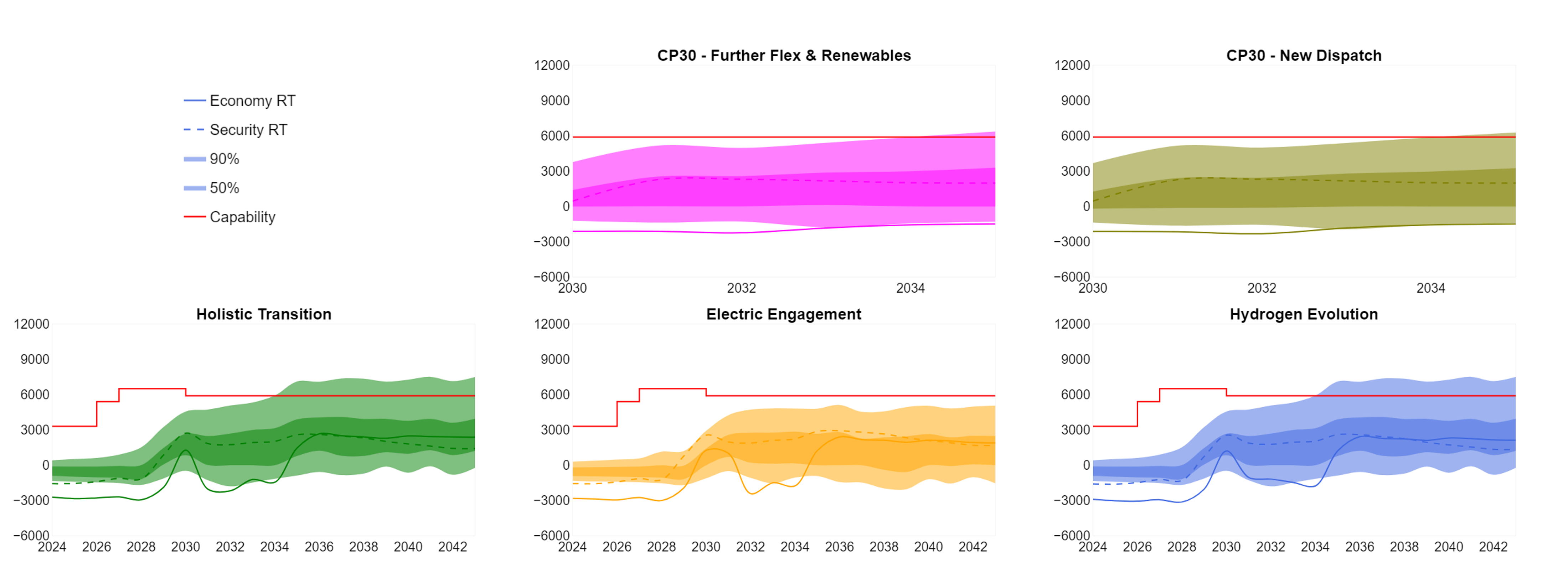
View an interactive version of the graph
The capability line (in red) is based on the recommendations from the Beyond 2030 optimal path which uses the 2023 FES and ETYS data as inputs. The 50%, 90%, Economy RT and Security RT lines are based on FES 2024 and Clean Power 2030 pathways. The ETYS and NOA methodologies for this boundary are different and can result in different transfer capabilities.
The boundary capability is limited to 3.5 GW due to a voltage constraint for a fault on the Landulph - Langage 400kV double circuit.

The circuits entering from the north can be particularly heavily loaded at winter peak conditions. The circuits are further overloaded when the European interconnectors export to mainland Europe as power is transported via London to feed the interconnectors along the south coast.
As the transfer across this boundary is mostly dictated by the contained demand, the scenario requirements mostly follow the increasing demand with little deviation due to generation changes.
The boundary requirements are close to each other across all scenarios for security and economy required transfer. In both criteria, the required transfer is significantly above the 95th percentile flows.
Boundary flows and base capability
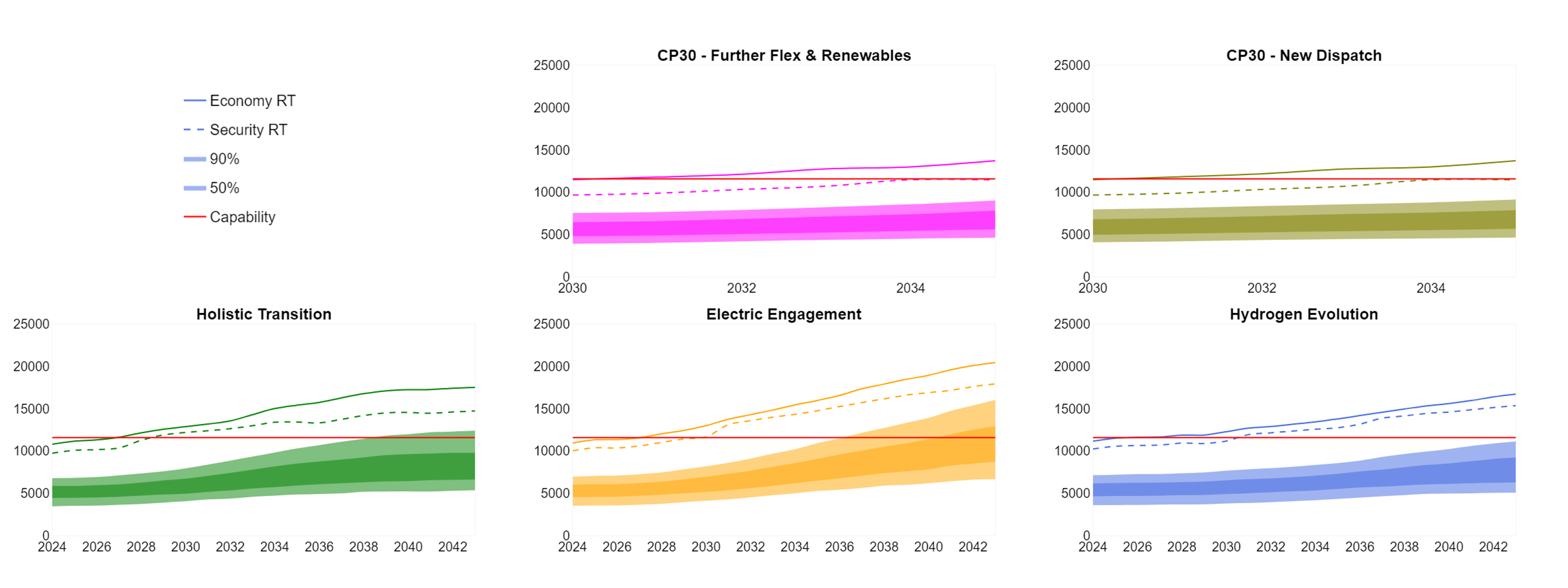
View an interactive version of the graph
The capability line (in red) is based on the recommendations from the Beyond 2030 optimal path which uses the 2023 FES and ETYS data as inputs. The 50%, 90%, Economy RT and Security RT lines are based on FES 2024 and Clean Power 2030 pathways. The ETYS and NOA methodologies for this boundary are different and can result in different transfer capabilities.
The boundary capability is limited to 11.6GW due to a thermal constraint on the Grain - Kingsnorth & Grain - Tilbury circuits.

During winter peak demand, the power typically flows from north to south across the boundary due to the low volumes of local generation on the south coast.
Interconnector activity significantly influences this boundary power flow. Currently, interconnectors to France, the Netherlands, and Belgium connect at Sellindge, Grain, and Richborough, respectively. The most significant driver for future requirements across SC1 will continue to be the connection of new continental interconnectors.
These interconnectors have a substantial impact on power transfers across SC1 and can, at times, complicate the management of network flows & constraints in real-time. For instance, a 2GW interconnector like IFA can cause a 4GW difference on the boundary, switching from full export to full import mode or vice versa.
Across all FES, the expected flows move further into the importing region over future years. Capability is expected to be sufficient for both importing and exporting cases.
Boundary flows and base capability
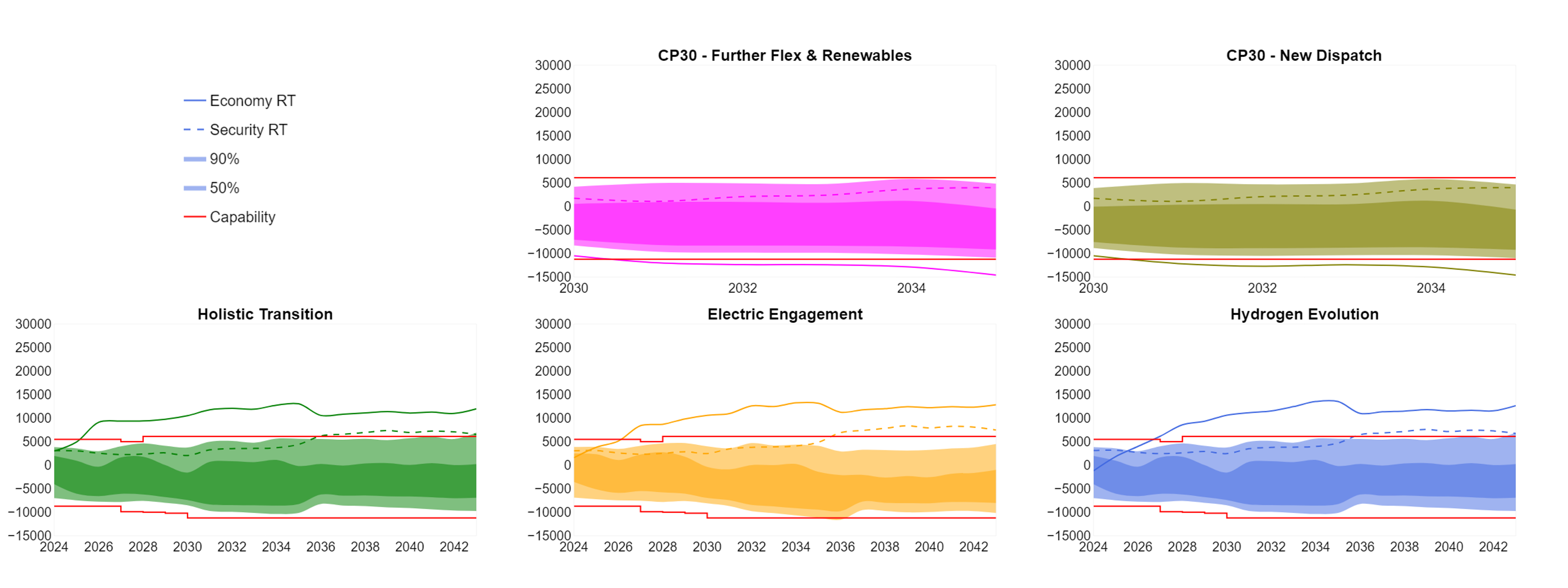
View an interactive version of the graph
The capability line (in red) is based on the recommendations from the Beyond 2030 optimal path which uses the 2023 FES and ETYS data as inputs. The 50%, 90%, Economy RT and Security RT lines are based on FES 2024 and Clean Power 2030 pathways. The ETYS and NOA methodologies for this boundary are different and can result in different transfer capabilities.
A reverse boundary capability has also been provided for this boundary (the boundary capability identified under scenarios where SC1 is importing power from the rest of GB) as this boundary is expected to import power for significant periods of time either now or in the future.
The boundary capability is limited to 3.9 GW due to a voltage compliance constraint at the Dungeness 400kV substation.
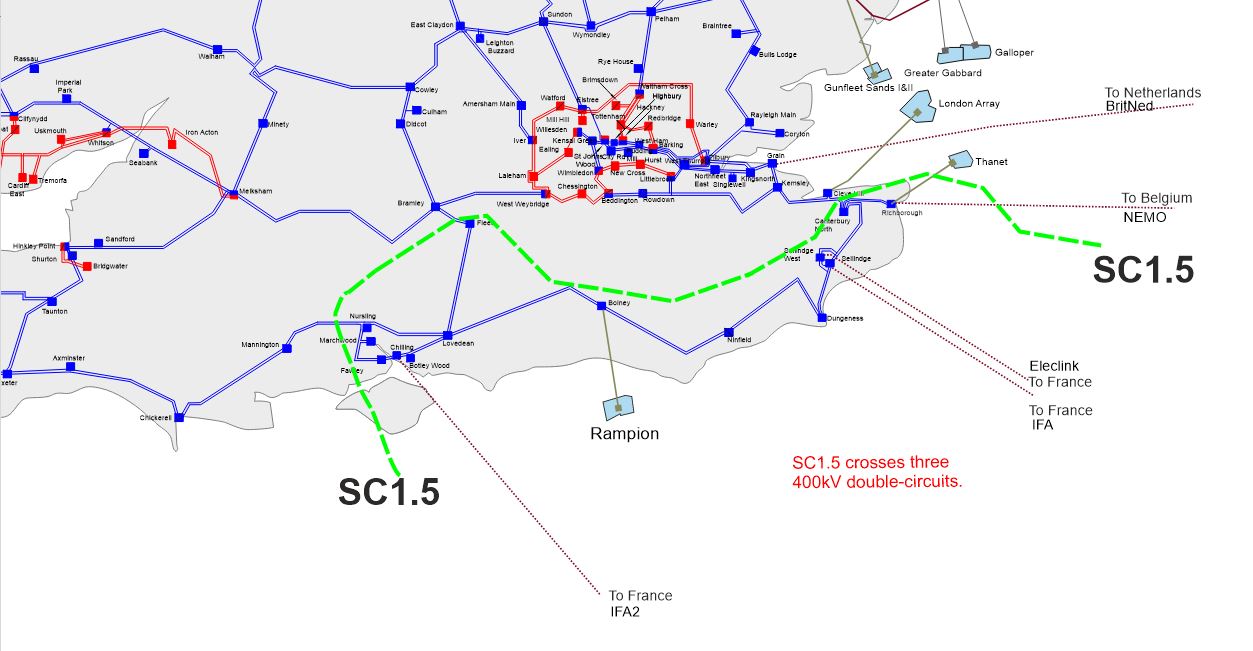
During peak winter demand in, power typically flows from north to south across the boundary due to the low volumes of local generation on the south coast.
The volatility of interconnector activity can be seen in the wide spread of expected boundary flows depicted by the shaded areas on the boundary charts.
Across all FES, the expected flows move slightly more toward importing on average, over future years. Capability is expected to be sufficient for both importing and exporting cases.
Boundary flows and base capability

View an interactive version of the graph
The capability line (in red) is based on the recommendations from the Beyond 2030 optimal path which uses the 2023 FES and ETYS data as inputs. The 50%, 90%, Economy RT and Security RT lines are based on FES 2024 and Clean Power 2030 pathways. The ETYS and NOA methodologies for this boundary are different and can result in different transfer capabilities.
A reverse boundary capability has also been provided for this boundary (the boundary capability identified under scenarios where SC1 is importing power from the rest of GB) as this boundary is expected to import power for significant periods of time either now or in the future.
The boundary capability is limited to 5.4 GW due to a voltage constraint for a fault on the Cleve Hill – Canterbury North – Kemsley 400kV circuits.

The 400kV route between Kemsley and Lovedean is relatively long and serves significant demand while connecting large generators and interconnections to Europe. A fault at either end can turn it into a long radial feeder, placing all the load on the remaining two circuits. This can be restrictive due to circuit ratings and may cause voltage issues.
Additional generation and interconnectors contracted for connection below SC2 could lead to some constraints when windy periods occur in combination with outages around the south east coast.
Across all FES, expected flows are projected to shift slightly more towards importing on average over the coming years. However, the capability is expected to be sufficient for both importing and exporting cases.
Boundary flows and base capability
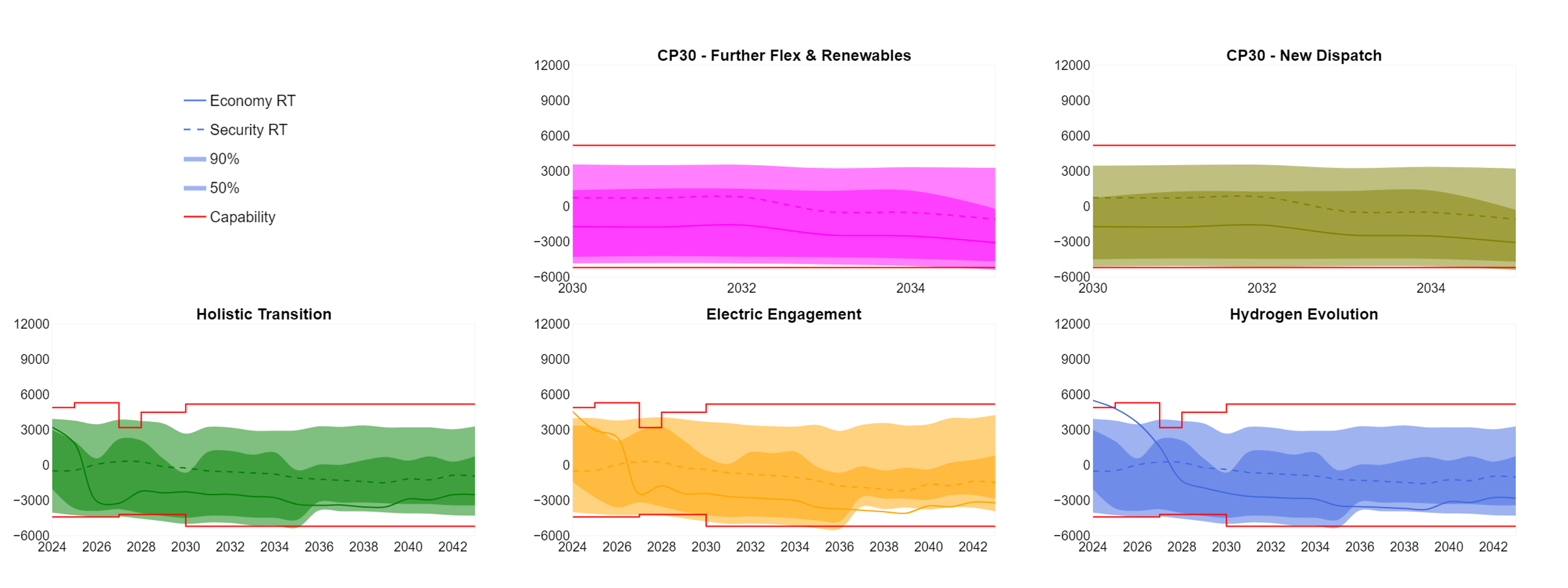
View an interactive version of the graph
The capability line (in red) is based on the recommendations from the Beyond 2030 optimal path which uses the 2023 FES and ETYS data as inputs. The 50%, 90%, Economy RT and Security RT lines are based on FES 2024 and Clean Power 2030 pathways. The ETYS and NOA methodologies for this boundary are different and can result in different transfer capabilities.
A reverse boundary capability has also been provided for this boundary (the boundary capability identified under scenarios where SC1 is importing power from the rest of GB) as this boundary is expected to import power for significant periods of time either now or in the future.
The boundary capability is limited to 3.8GW due to voltage compliance constraints.

The current and future interconnectors to Europe have a significant impact on the power transfers across SC3. The current interconnectors to France, the Netherlands and Belgium connect at Sellindge, Grain and Richborough respectively.
Across all FES, the expected flows move slightly more toward importing on average, whilst still expected to regularly export power for limited periods, in future years. Capability is expected to be sufficient for both importing and exporting cases.
Boundary flows and base capability

View an interactive version of the graph
The capability line (in red) is based on the recommendations from the Beyond 2030 optimal path which uses the 2023 FES and ETYS data as inputs. The 50%, 90%, Economy RT and Security RT lines are based on FES 2024 and Clean Power 2030 pathways. The ETYS and NOA methodologies for this boundary are different and can result in different transfer capabilities.
A reverse boundary capability has also been provided for this boundary (the boundary capability identified under scenarios where SC1 is importing power from the rest of GB) as this boundary is expected to import power for significant periods of time either now or in the future.
The boundary capability is limited to 6.7GW due to a thermal constraint on the Grain – Tilbury 400kV circuit.

LE1 is characterised by two distinct areas. Within London, there is high local demand and little generation. The remainder of the area contains both high demand and high levels of generation.
LE1 almost exclusively imports power from the north and west into the south-east, and the purpose of the boundary is to monitor flows in this direction. Due to this and for ease of reading, LE1 is defined in the reverse manner, positive flows on the boundary charts indicate power flowing into LE1 (importing).
Increasing interconnector exports to Europe drive an increase in power flows and a need for network reinforcements in the area over the coming years. By 2030 capability rises above the 95th percentile of expected flows in all pathways which will reduce constraints in the south east.
Boundary flows and base capability
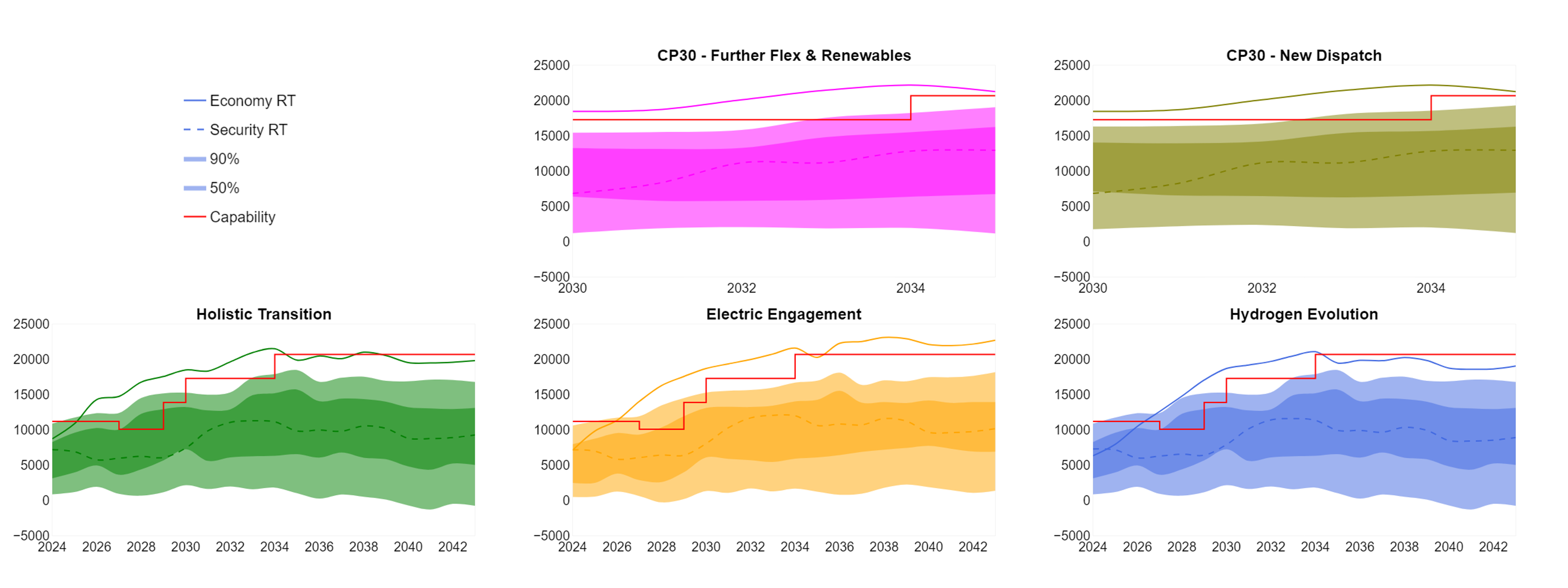
View an interactive version of the graph
The capability line (in red) is based on the recommendations from the Beyond 2030 optimal path which uses the 2023 FES and ETYS data as inputs. The 50%, 90%, Economy RT and Security RT lines are based on FES 2024 and Clean Power 2030 pathways. The ETYS and NOA methodologies for this boundary are different and can result in different transfer capabilities.
The boundary capability is limited to 10.2 GW due to a voltage constraint for a fault on the Pelham-Bramford-Braintree 400kV circuits.

Contained within the boundary is a mixture of generation types including renewable generation and fossil fuel generation which are expected to close.
South Wales includes demand consumptions from the major cities, including Swansea and Cardiff, and the surrounding industry.
The boundary requirements are within the boundary’s present capability, and we expect this to remain the case for the foreseeable future, as seen in the boundary chart.
The NESO’s final recommended design for the Celtic Sea offshore sees up to 3GW of floating offshore wind connecting into South Wales, behind SW1, by 2035.
Boundary flows and base capability

View an interactive version of the graph
The capability line (in red) is based on the recommendations from the Beyond 2030 optimal path which uses the 2023 FES and ETYS data as inputs. The 50%, 90%, Economy RT and Security RT lines are based on FES 2024 and Clean Power 2030 pathways. The ETYS and NOA methodologies for this boundary are different and can result in different transfer capabilities.
The boundary capability is limited to 3.8 GW due to a thermal constraint on the Imperial Park – Melksham 400kV circuit.
